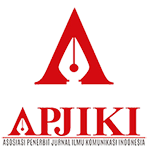ISLAMIC BRANDING ASINAN BETAWI MAK HAJI
Abstract
Islamic branding as one of the strategies is a necessity, to be able to enter the Indonesian market which is so large with its Muslim community. Strategies carried out on brands that describe Islamic identity. This research tries to look at various aspects of marketing communication related to branding through Islamic branding from Asinan Betawi Mak Haji. The research formula is, How about Islamic Branding Asinan Betawi Mak Haji? with research purposes; 1) The form of branding Asinan Betawi Mak Haji; 2) Islamic branding Asinan Betawi Mak Haji. The research used is qualitative methods with narrative analysis in expressing and analyzing how the communicator tells a story objectively from 1 (one) key informant and 2 (two) informants including triangulation. The conclusion was that the Asinan Betawi business began in 2018, which at that time did not yet have a brand and promotional activities and product marketing through social media Facebook and Instagram. There are 5 (five) forms of Asinan Betawi Mak Haji branding to differentiate the product from others. The word 'Mak Haji' which is translated into visual identity is a logogram and adds the MAK HAJI logotype to strengthen the brand identity, which reflects the vision, personality and existence of Islamic branding. It is hoped that this research will be useful to provide references as well as input and consideration for further research and activists of the halal industry in building Islamic branding.
Keywords
Full Text:
PDFReferences
Ekonom.ibisnis.com. (2020). Indonesia Masuk 3 Besar Investasi Produk Halal Dunia 2020, Tapi. https://ekonomi.bisnis.com/read/20201202/12/1325404/indonesia-masuk-3-besar-investasi-produk-halal-dunia-2020-tapi. Diakses 11 Januari 2021.
Nasrullah, M. (2015). Islamic Branding, Religiusitas dan Keputusan Konsumen terhadap Produk. Jurnal Hukum Islam, 13 (2), 79-87. DOI:10.28918/jhi.v13i2.487.
Mudzakkir, M.F. dan Nurfarida, I.N. (2014). Religiousity Commitment dalam Memoderasi Hubungan Brand Awareness terhadap Niat Pembelian. Jurnal Ekonomi Modernisasi, 10 (1), 170-177. DOI:10.21067/jem.v10i3.850.
Ranto, D.W.P. (2013). Menciptakan Islamic Branding Sebagai Strategi Menarik Minat Beli. Jurnal JBMA, 1(2), 1-11.http://jurnal.amaypk.ac.id/index.php/jbma/article/view/9.
Griffin, E.A. (2012). A First Look at Communication Theory. New York: McGraw-Hill.
Hasan, A. (2013). Marketing dan Kasus-kasus Pilihan. Yogyakarta: CAPS.
Rusman, K., Warouw, D.M.D dan Pasoreh, Y. (2013). Peranan Komunikasi Pemasaran dalam Meningkatkan Hasil Penjualan Produk PT. Pokphan Luwuk Sulawesi Tengah. Journal Acta Diurna, 4 (5), 1-14. https://ejournal.unsrat.ac.id/index.php/actadiurnakomunikasi/article/view/9455
Kotler, P. dan Keller, K.L. (2009). Manajemen Pemasaran Edisi 13 Jilid 1. Jakarta: Penerbit Erlangga.
Aaker, D. (2015). Aaker on Branding, 20 Prinsip Esensial Mengelola dan Mengembangkan Brand. Jakarta: PT. Gramedia Pustaka Utama.
Smith, P.R. and Zook, Z. (2011). Marketing Communications, Integrating Offline and Online with Social Media. London: Kogan Page Limited.
Kornberger, M. (2010). Brand Society How Brands Transform Management and Lifestyle. Cambridge University Press.
Hermanto, A. dan Aldawiyah, S.E. (2020). Branding dan Positioning Identitas Budaya Indonesia dalam Pesan Iklan TV Komersial Bedjo Bintang Toedjo Jahe Merah. Jurnal Interaksi, 4 (1), 24-40. DOI: http://dx.doi.org/10.30596%2Finteraksi.v4i1.3958.
Taufandra, M. dan Rahanatha, G.B. (2014). Pengaruh Citra Merek Terhadap Persepsi Kualitas dan Loyalitas Merek. Jurnal Manajemen Universitas Udayana, 3 (11), 342-356. DOI: https://doi.org/10.22219/jmb.v6i2.554.
Maryati, W. (2012). Brand Management Through Long-Term Strategy of The Strengthening of Brand Equity. Jurnal Enterpreneur. 3 (1), 11-21. http://journal.unipdu.ac.id:8080/index.php/Entrepreneur/article/view/339.
Yusof, M. and Jusoh, W. (2014). Islamic Branding: The Understanding and Perception. INCOMaR 2013. Procedia-Social and Behavioral Sciences 130, 179-185. DOI:10.1016/j.sbspro.2014.04.022.
Alserhan, B.A. (2010). Islamic Branding: A Conceptualization of Related Terms. Journal of Brand Management, 18 (1), 34-49. DOI:10.1057/bm.2010.18.
Moleong. (2018). Metodologi Penelitian Kualitatif edisi revisi. Bandung: PT. Remaja Rosdakarya.
Sugiono. (2014). Metode Penelitian Kombinasi (Mixed Methods) Cetakan ke-6. Bandung. Penerbit Alpabeta.
Nazir, M. (2013). Metode Penelitian. Bogor: Penerbit Ghalia Indonesia.
Facebook. (2021). Asinan.makhaji76. https://web.facebook.com/asinan.makhaji. Diakses 7 Pebruari 2021.
Instagram. (2021). Asinan.makhaji76. https://www.instagram.com/asinan.makhaji76/. Diakses 7 Pebruari 2021.
DOI: https://doi.org/10.32509/wacana.v21i1.1679
Refbacks
- There are currently no refbacks.

This work is licensed under a Creative Commons Attribution-NonCommercial-ShareAlike 4.0 International License.
Indexed by:
Recommended Tools :
Wacana: Jurnal Ilmiah Ilmu Komunikasi
Fakultas Ilmu Komunikasi, Universitas Prof. Dr. Moestopo (Beragama)
Kampus I, Jl. Hang Lekir I/8 Jakarta Pusat, Indonesia 10270
WA: 085714422271 (Chat Only)
email: wacana@dsn.moestopo.ac.id
Copyright (c) 2025 Wacana: Jurnal Ilmiah Ilmu Komunikasi
Licensed under a Creative Commons Attribution-ShareAlike 4.0 International License.













